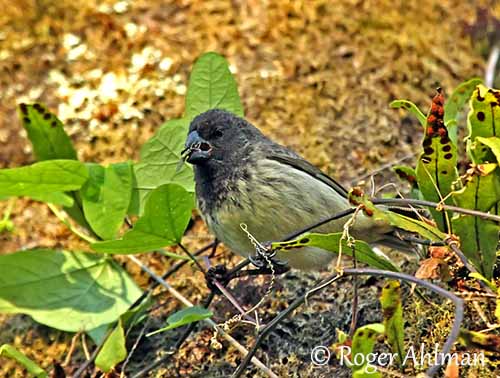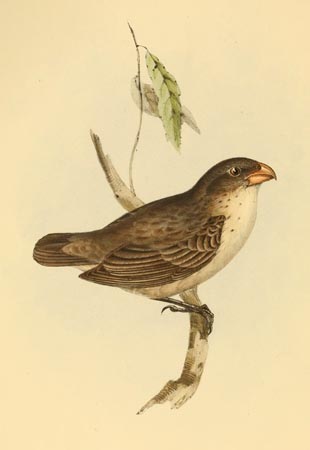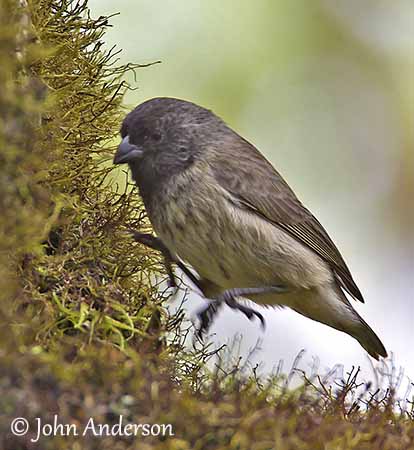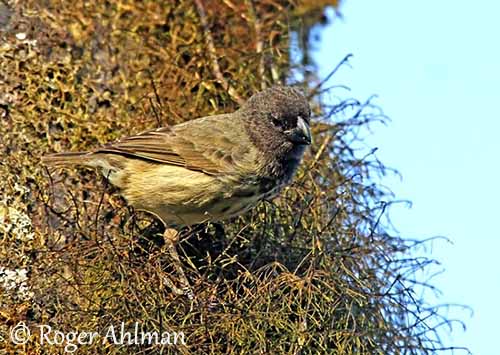
Fr: Géospize psittacin
All: Papageischnabel-Darwinfink
Esp: Pinzón de Darwin Lorito
Ita: Fringuello arboricolo grosso
Nd: Grote Boomvink
Sd: Större trädfink
Photographers:
Roger Ahlman
Pbase Galleries Peru and Ecuador
John Anderson
John Anderson Photo Galleries
Illustration:
John Gould: 1804-1881
Text by Nicole Bouglouan
Sources:
HANDBOOK OF THE BIRDS OF THE WORLD Vol 16 by Josep del Hoyo- Andrew Elliot-David Christie – Lynx Edicions – ISBN: 9788496553781
HANDBOOK OF THE BIRDS OF THE WORLD Vol 16 by Josep del Hoyo- Andrew Elliot-David Christie – Lynx Edicions – ISBN: 9788496553781
BirdLife International (BirdLife International)
Neotropical Birds – Cornell Lab of Ornithology
Large Tree-Finch
Camarhynchus psittacula
Passeriformes Order – Thraupidae Family
Darwin’s Finches - Generalities
INTRODUCTION:
The Large Tree-Finch is the largest of the genus Camarhynchus. This is mainly an arboreal species and an insect-eater. Both scientific and French names could illustrate the repetitive song of this species, but also its strongly arched bill a bit similar to that of a parrot.
DESCRIPTION OF THE BIRD:
Biometrics:
Length: 13 cm
Weight: 15-21 g
The adult male of the nominate race has greyish-olive upperparts with blackish feather centres. The tail is short.
The underparts are whitish with yellowish-buff wash. Lower breast and flanks are streaked dark. The undertail-coverts are buffy-white and unstreaked.
The head is dark, forming a blackish hood extending down to throat and breast.
The deep, relatively long bill has strongly arched culmen. It is black when breeding, and dull orange with dark culmen outside the breeding season. The eyes are dark brown. Legs and feet are black.

The female has duller greyish-brown upperparts. The upperwing is brownish with two narrow pale wingbars.
The underparts are whitish with indistinct dark streaking on breast, variable according to each bird. From belly to undertail-coverts, the plumage is plain pale buff.
The head is greyish-brown with pale supercilium.
The bill is dull orange with darker culmen. The eyes are dark. Legs and feet are blackish.
The immature male resembles female, with blackish forehead, face and lower throat.

SUBSPECIES AND RANGE:
There are three subspecies.
C.p. habeli occurs on Pinta and Marchena Islands, in N Galapagos Islands. This race is smaller than nominate. The male is darker too. The bill is longer, with less arched culmen.
C.p. affinis is found on Fernandina and Isabela Islands, in W Galapagos Islands. This one is smaller than nominate, with smaller bill too.
C.p. psittacula (here described and displayed) occurs on Santiago, Rábida, Santa Cruz, Santa Fe and Floreana, in C and S Galapagos Islands.
HABITAT:
The Large Tree-Finch frequents mainly humid evergreen forest between 300 and 700 metres of elevation. However, during the dry season, it may move to lower areas with deciduous trees, shrubs and Opuntia cacti.
CALLS AND SONGS: SOUNDS BY XENO-CANTO
The Large Tree-Finch’s call is a nasal “tzeeuu”. The song is a series of repeated notes “chu-tzee chu-tzee chut-zee”. This song can be given by both mates.
Like in other Darwin’s Finches, the song includes various trills and buzzes.
BEHAVIOUR IN THE WILD:
The Large Tree-Finch feeds primarily on arthropods, but it also takes cactus fruits and other fruits, flowers and seeds.
During the nesting season, the chicks are fed with a mixed diet including arthropods, fruits and seeds. Outside the breeding season, it feeds mainly on seeds according to the size of its bill.
It forages in trees, probing and biting into the bark of twigs, in order to extract insects and larvae, but also caterpillars.

BEHAVIOUR IN THE WILD:
The Large Tree-Finch feeds primarily on arthropods, but it also takes cactus fruits and other fruits, flowers and seeds.
During the nesting season, the chicks are fed with a mixed diet including arthropods, fruits and seeds. Outside the breeding season, it feeds mainly on seeds according to the size of its bill.
It forages in trees, probing and biting into the bark of twigs, in order to extract insects and larvae, but also caterpillars.
The breeding season is associated with rains, involving abundant food resources. The Large Tree-Finch is monogamous and the pair defends a small territory. They often have long-term pair-bonds. The male is territorial and guards the female during the egg-laying.
This species is resident in its range, only performing some altitudinal movements during the dry season.
REPRODUCTION OF THIS SPECIES:
The breeding season occurs during the wet period.
The male builds the nest, a spherical structure with lateral entrance towards the top. The nest is made with dry grasses, moss and lichen.
The female lays 4 whitish eggs with darker spots. She incubates alone during 12 days. The chicks are fed by both parents. They fledge about 13-15 days after hatching.
PROTECTION / THREATS / STATUS:
The Large Tree-Finch is common within its range, and its populations appear to be stable.
This species is not currently threatened.
